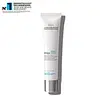What's inside
What's inside
 Key Ingredients
Key Ingredients

 Benefits
Benefits

 Concerns
Concerns

 Ingredients Side-by-side
Ingredients Side-by-side

Water
Skin ConditioningGlycerin
HumectantButylene Glycol
HumectantEthylhexyl Palmitate
EmollientHydroxyethyl Acrylate/Sodium Acryloyldimethyl Taurate Copolymer
Emulsion StabilisingSodium Polyacrylate
AbsorbentSodium Hyaluronate
HumectantSqualane
EmollientPentylene Glycol
Skin ConditioningCaprylyl Glycol
EmollientCarnosine
Skin Conditioning1,2-Hexanediol
Skin ConditioningCaffeine
Skin ConditioningSodium Citrate
BufferingGlyceryl Acrylate/Acrylic Acid Copolymer
HumectantPolysorbate 60
EmulsifyingPhenoxyethanol
PreservativeSilica Dimethyl Silylate
EmollientPropylene Glycol
HumectantAdenosine
Skin ConditioningNeoruscogenin
Skin ConditioningSorbitan Isostearate
EmulsifyingRuscogenin
Skin ConditioningDisodium Adenosine Triphosphate
Skin ConditioningHexylene Glycol
EmulsifyingLaminaria Digitata Extract
Skin ProtectingWater, Glycerin, Butylene Glycol, Ethylhexyl Palmitate, Hydroxyethyl Acrylate/Sodium Acryloyldimethyl Taurate Copolymer, Sodium Polyacrylate, Sodium Hyaluronate, Squalane, Pentylene Glycol, Caprylyl Glycol, Carnosine, 1,2-Hexanediol, Caffeine, Sodium Citrate, Glyceryl Acrylate/Acrylic Acid Copolymer, Polysorbate 60, Phenoxyethanol, Silica Dimethyl Silylate, Propylene Glycol, Adenosine, Neoruscogenin, Sorbitan Isostearate, Ruscogenin, Disodium Adenosine Triphosphate, Hexylene Glycol, Laminaria Digitata Extract
Water
Skin ConditioningGlycerin
HumectantDimethicone
EmollientHydrogenated Polyisobutene
EmollientPropylene Glycol
HumectantHydroxypropyl Tetrahydropyrantriol
Skin ConditioningAlcohol Denat.
AntimicrobialPropanediol
SolventPanthenol
Skin ConditioningSynthetic Wax
AbrasiveNylon-12
PEG-10 Dimethicone
Skin ConditioningDimethicone/PEG-10/15 Crosspolymer
Hydroxyethylpiperazine Ethane Sulfonic Acid
BufferingTocopherol
AntioxidantSodium Polyacrylate
AbsorbentSodium Hyaluronate
HumectantHydrolyzed Hyaluronic Acid
HumectantSodium Citrate
BufferingPhenoxyethanol
PreservativeAdenosine
Skin ConditioningChlorphenesin
AntimicrobialPropylene Carbonate
SolventDipropylene Glycol
HumectantDisteardimonium Hectorite
StabilisingDisodium EDTA
Parfum
MaskingWater, Glycerin, Dimethicone, Hydrogenated Polyisobutene, Propylene Glycol, Hydroxypropyl Tetrahydropyrantriol, Alcohol Denat., Propanediol, Panthenol, Synthetic Wax, Nylon-12, PEG-10 Dimethicone, Dimethicone/PEG-10/15 Crosspolymer, Hydroxyethylpiperazine Ethane Sulfonic Acid, Tocopherol, Sodium Polyacrylate, Sodium Hyaluronate, Hydrolyzed Hyaluronic Acid, Sodium Citrate, Phenoxyethanol, Adenosine, Chlorphenesin, Propylene Carbonate, Dipropylene Glycol, Disteardimonium Hectorite, Disodium EDTA, Parfum
Ingredients Explained
These ingredients are found in both products.
Ingredients higher up in an ingredient list are typically present in a larger amount.
Adenosine is in every living organism. It is one of four components in nucleic acids that helps store our DNA.
Adenosine has many benefits when used. These benefits include hydrating the skin, smoothing skin, and reducing wrinkles. Once applied, adenosine increases collagen production. It also helps with improving firmness and tissue repair.
Studies have found adenosine may also help with wound healing.
In skincare products, Adenosine is usually derived from yeast.
Learn more about AdenosineGlycerin is already naturally found in your skin. It helps moisturize and protect your skin.
A study from 2016 found glycerin to be more effective as a humectant than AHAs and hyaluronic acid.
As a humectant, it helps the skin stay hydrated by pulling moisture to your skin. The low molecular weight of glycerin allows it to pull moisture into the deeper layers of your skin.
Hydrated skin improves your skin barrier; Your skin barrier helps protect against irritants and bacteria.
Glycerin has also been found to have antimicrobial and antiviral properties. Due to these properties, glycerin is often used in wound and burn treatments.
In cosmetics, glycerin is usually derived from plants such as soybean or palm. However, it can also be sourced from animals, such as tallow or animal fat.
This ingredient is organic, colorless, odorless, and non-toxic.
Glycerin is the name for this ingredient in American English. British English uses Glycerol/Glycerine.
Learn more about GlycerinPhenoxyethanol is a preservative that has germicide, antimicrobial, and aromatic properties. Studies show that phenoxyethanol can prevent microbial growth. By itself, it has a scent that is similar to that of a rose.
It's often used in formulations along with Caprylyl Glycol to preserve the shelf life of products.
Propylene Glycol is an odorless, colorless liquid. As a humectant, it helps skin retain moisture. It also aids in delivering active ingredients.
Another role of this ingredient is preventing a product from melting or freezing. Propylene glycol also adds antimicrobrial properties to a product, elongating product lifespan.
This ingredient is considered an organic alcohol and commonly added into both cosmetics and foods.
Those with sensitive skin or conditions may develop a rash when using this ingredient.
Learn more about Propylene GlycolSodium Citrate is the sodium salts of citric acid. In skincare, it is used to alter pH levels and acts as a preservative.
Its main functions are to maintain the pH of a product and neutralize metal ions.
The acidity of our skin is maintained by our glands and skin biome; normal pH level of skin is slightly acidic (~4.75-5.5).
Being slightly acidic allows our skin to create an "acid mantle". This acid mantle is a thin barrier that protects our skin from bacteria and contaminants.
Learn more about Sodium CitrateSodium Hyaluronate is hyaluronic acid's salt form. It is commonly derived from the sodium salt of hyaluronic acid.
Like hyaluronic acid, it is great at holding water and acts as a humectant. This makes it a great skin hydrating ingredient.
Sodium Hyaluronate is naturally occurring in our bodies and is mostly found in eye fluid and joints.
These are some other common types of Hyaluronic Acid:
Learn more about Sodium HyaluronateSodium Polyacrylate is the sodium salt of polyacrylic acid. It is used as an absorber, emollient, and stabilizer.
This ingredient is a super-absorbent polymer - meaning it can absorb 100 to 1000 times its mass in water. As an emollient, Sodium Polyacrylate helps soften and soothe skin. Emollients work by creating a barrier to trap moisture in. This helps keep your skin hydrated.
Water. It's the most common cosmetic ingredient of all. You'll usually see it at the top of ingredient lists, meaning that it makes up the largest part of the product.
So why is it so popular? Water most often acts as a solvent - this means that it helps dissolve other ingredients into the formulation.
You'll also recognize water as that liquid we all need to stay alive. If you see this, drink a glass of water. Stay hydrated!
Learn more about Water